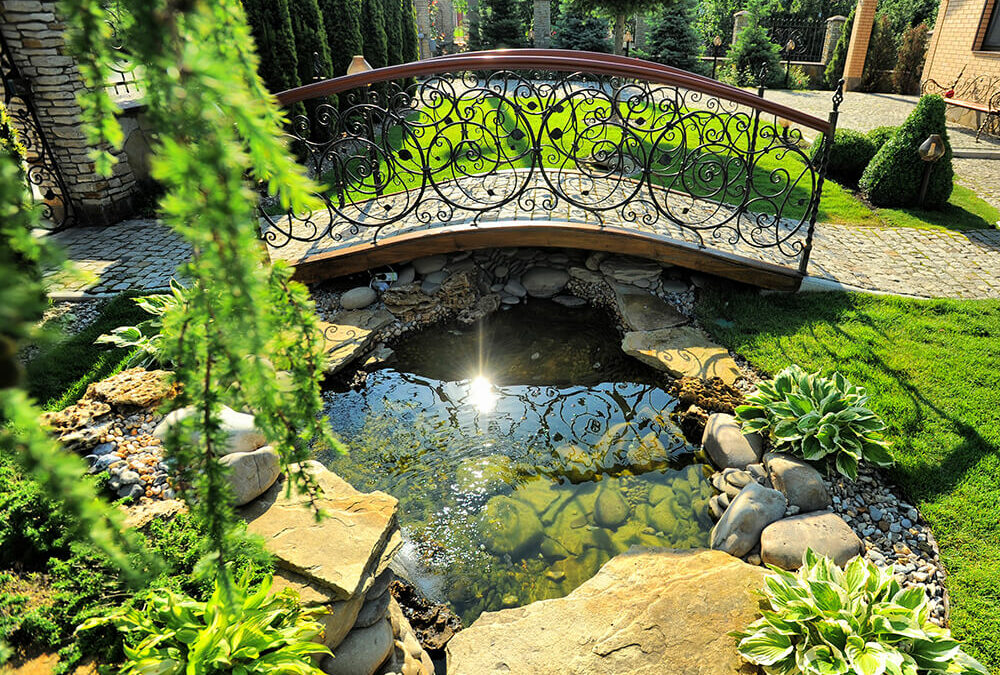
by A Touch of Dutch Landscaping | Oct 27, 2020 | Fencing, Flowers, Gardening, Hardscaping, Landscape Design, Native Plants, Patios, Ponds, Retaining Walls, Shrubs, Softscaping, Trees, Walkways, Water Features
Landscaping is a fantastic way to upgrade your home’s exterior. Done right, it improves curb appeal and enhances your enjoyment and the functionality of your outdoor environment.
And, like the clothing and home décor you choose, landscaping also provides an excellent opportunity to express your personal style. You may have inherited an already established landscape design when you moved into your home. Or you may have previously defaulted to a style that you thought suited your home’s exterior style.
While matching the style of your home may be a factor you want to consider, the design can be updated to better reflect your personal style as well.
If you haven’t given much thought to your landscaping style, we’ll outline the major styles, their differences, and their defining elements. When we get right down to it, there are really only two principal styles – traditional and contemporary (or “modern”) – with many substyles that can play a role in the overall design.
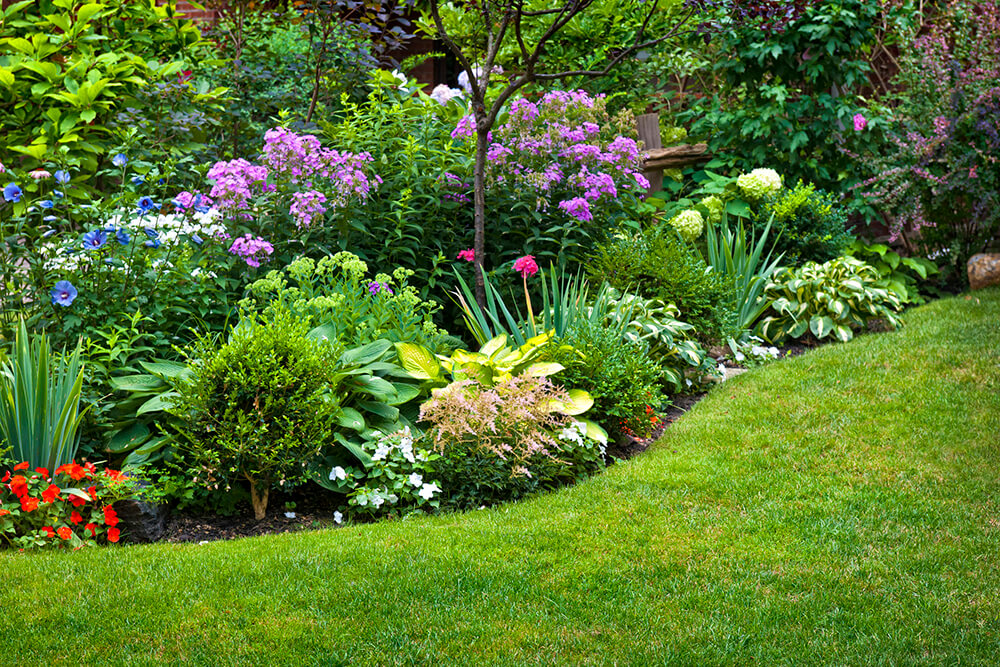
An example of a traditional garden design overflowing with a mixture of native plants and flowers
The traditional landscaping style tends to be associated with soft or curved lines, more rustic, textural materials in muted, mottled tones, and a balanced mixture of softscaping, hardscaping, and water elements that create a relaxed, laid back atmosphere. More often than not, traditional landscape design tends to be associated with the “informal” style. Because of its more free-flowing lines, a traditionally designed landscape can be more desirable for those wanting a lower maintenance outdoor living area.
Contemporary Landscape Design
On the other end of the spectrum, modern landscape design employs straight lines, clean edges, and sharp angles. Contemporary landscapes offer steep contrast in colour, with lots of symmetry in the shape and size of its elements. Hardscaping materials tend to be flat with a matte or polished finish. These attributes lend to what is generally considered a more “formal” style and also tend to demand more work to maintain the shapes and symmetrical appearance.
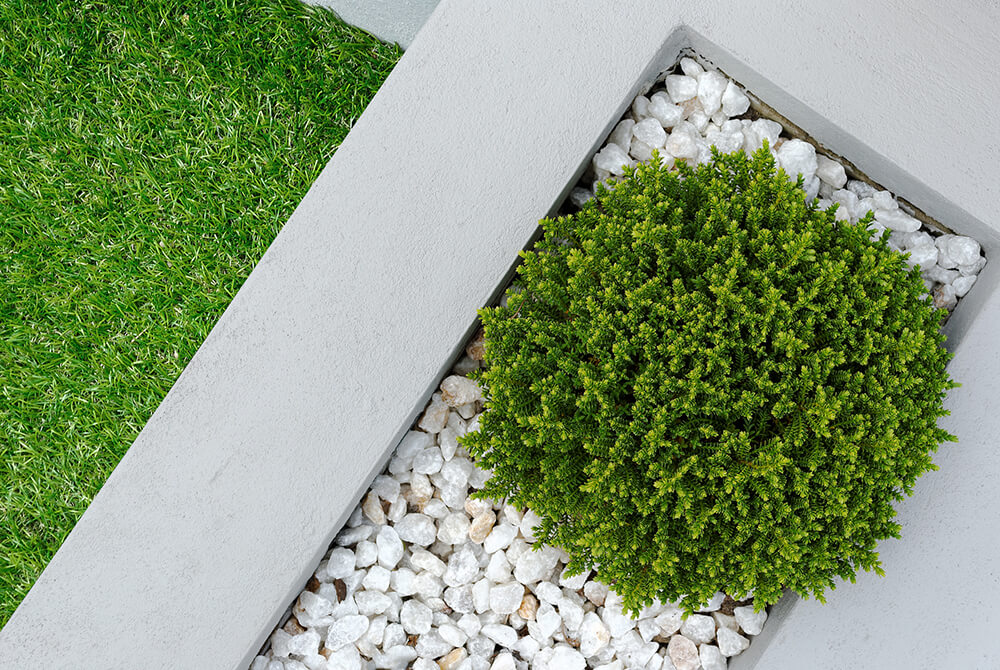
Elements of modern landscape design – clean lines, right angles, and monochromatic colour scheme
Generally speaking, while most landscape designs may primarily be classified as traditional or modern, they really fall somewhere in between. Besides your personal style, here are many good reasons for a hybrid design, including:
- Soil conditions and light exposure
- How you use your yard
- Your proclivity for garden maintenance
- Your home’s exterior style
Substyles and Themes
If you don’t want your yard to be purely traditional or one hundred percent contemporary, below are a few substyles/themes you can work into your design.
Native
Plants and trees are indigenous to Ontario/Canada. These not only attract birds, bees, butterflies, and other native wildlife, but also tend to require less maintenance because they’re well-adapted to our climate.
Xeriscape
This type of landscaping reduces or eliminates the need for supplemental watering through the use of above-ground or underground water collection and circulation techniques in conjunction with more drought-tolerant plant and tree varieties.
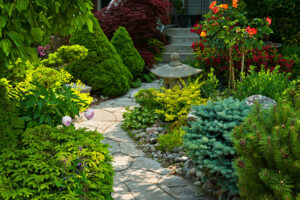
An example of Asian-inspired traditional landscape design with flagstone walkway
Asian-Inspired
Elements can include a pergola, gate, trickling water feature, ornamental grasses, koi pond, walkway or labyrinth, and soft lighting.
English Garden
Lush green lawns with one or more sitting areas among large, colourful gardens, overflowing with flowers, plants, and trees that attract a range of pollinators.
Natural/Organic
Plants and materials are sustainably sourced and managed. Can be easily combined with Native and/or Xeriscape themes.
Rustic
Incorporates wood and natural stone into decks, patios, walkways, fencing, sheltering structures, and retaining walls.
So, what’s your landscape style? Hopefully, this guide has provided some insights. If you’re having trouble deciding, we’re just a call or email away.

by A Touch of Dutch Landscaping | Mar 29, 2020 | Flowers, Gardening, Native Plants, Shrubs, Softscaping, Trees
Creating a healthy local ecosystem in our own backyards
There have been myriad reports over the past few months from backyard birders about the decrease in visitors to their feeders. If you’ve noticed this too, you’ll be pleased to know there are things we can each do to radically reverse the decline of small wildlife in our yards.
 It’s all well and good to provide seed and suet for birds, but the solution to population decline requires us to look a little closer. Instead of thinking short-term, say season by season, let’s look at it from a yearly perspective, or even longer.
It’s all well and good to provide seed and suet for birds, but the solution to population decline requires us to look a little closer. Instead of thinking short-term, say season by season, let’s look at it from a yearly perspective, or even longer.
What we choose to plant directly affects the quantity and activity of small and large living organisms in our yards. If our only priority is a yard that looks pretty, we may be missing opportunities to positively impact the local ecosystem.
We should also consider biodiversity – choosing a variety of species that co-exist nicely. If we also opt for plants and trees that require minimal resources for survival, then we can move toward a landscape that not only looks good, but is low-maintenance and welcomes beneficial interdependent activity above and below ground.
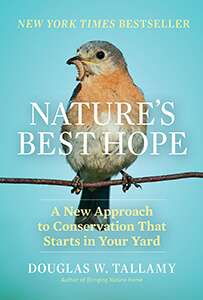 Wildlife Ecologist Doug Tallamy, author of “Nature’s Best Hope: A new approach to conservation that starts in your yard” offers strong arguments and simple tips for being a backyard conservationist. Here are a handful of his suggestions:
Wildlife Ecologist Doug Tallamy, author of “Nature’s Best Hope: A new approach to conservation that starts in your yard” offers strong arguments and simple tips for being a backyard conservationist. Here are a handful of his suggestions:
- Reduce the amount of lawn in your yard to that which you require for walking and playing. Fill this area instead with more productive “host” plants.
- Over thousands of years, native fauna has developed defences and tolerances (and thus, preferences) for consuming native flora (plants with which it has co-evolved), so naturally if we replace these native food sources with non-native alternatives, local wildlife will either have to go elsewhere for food or perish.
- If not kept in check, unproductive, foreign cultivars can become invasive species, choking out native plant life beyond our back yards.
- We currently have 3 billion fewer birds than we did 50 years ago. Globalization and hybridization have replaced native garden options with more “exotic” options that might be fashionable, but don’t contribute to the local ecosystem.
- A great deal of the animals in any ecosystem don’t eat plants, but eat something that eats something that eats plants, so ensuring the right plants are available as a food source for caterpillars and insects is a very big deal to our entire ecosystem.
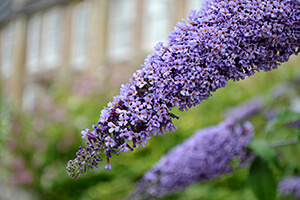 The good news is this isn’t an all-or-nothing proposition. You don’t have to swap out all of the plant life in your garden and risk disrupting your current modern or tropical motif, for example. Plants that are native to Ontario come in a wide range of shapes, sizes, and colours, so you’re sure to find a few cultivars that appeal to you.
The good news is this isn’t an all-or-nothing proposition. You don’t have to swap out all of the plant life in your garden and risk disrupting your current modern or tropical motif, for example. Plants that are native to Ontario come in a wide range of shapes, sizes, and colours, so you’re sure to find a few cultivars that appeal to you.
And adding just a few native plants and trees will produce favourable results. Visit our June 2019 post on Choosing Native Ontario Plants for Your Garden or head over to our Native Ontario Plants Pinterest Board for some inspiration.
As always, if you need assistance choosing the right native plants and trees for your yard, or you just want to get started on a landscaping project, contact us.
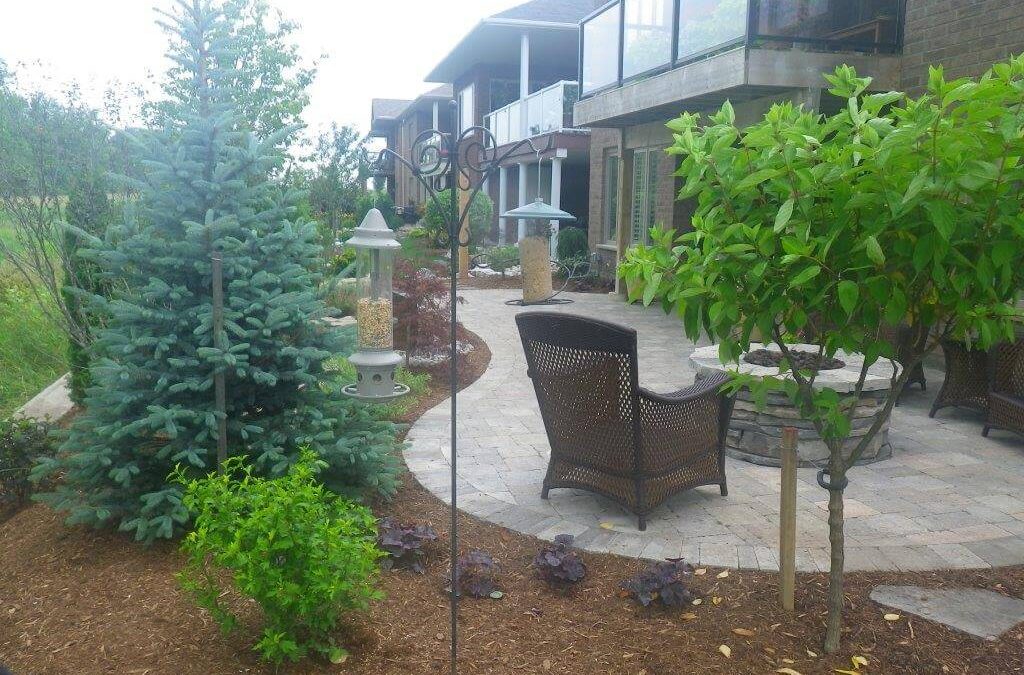
by A Touch of Dutch Landscaping | Jul 18, 2019 | Hardscaping, Landscape Design, Lawn care, Maintenance, Native Plants, Walkways
What to expect with low-maintenance landscaping
When we’re consulting with clients about their goals for new landscaping projects, by far the most requested characteristic is “low-maintenance”. But keep in mind that “low-maintenance” doesn’t mean “no maintenance”, so there’s still some work involved in keeping your lawn and garden looking great all season long.
If you’re looking to minimize the amount of work your lawn and flowerbeds need, we’ve got some tips that will allow you to spend more time enjoying your outdoor living spaces and less time maintaining them.
The Low-Maintenance Lawn
It may surprise you to learn that your lawn generally requires a lot more time to maintain that gardens do. Weeding, feeding, seeding, sodding, cutting, trimming, and watering all repeatedly require time, effort, and resources.
As such, the first thing we recommend doing is considering how much lawn you need for your lifestyle. While grass-covered turf does offer certain environmental benefits like absorbing toxins and carbon dioxide, other landscaping options can be just as beneficial. Chances are you can drastically reduce the amount of grass in your yard and replace those areas with other, much lower-maintenance elements.
One sure-fire way to reduce high-maintenance grass is to add some hardscaping to your yard. In addition to your driveway, porch, and deck, you might consider expanding your living space with a stone patio, fire pit area, and/or walkways. Adding crushed stone and pavers to high-traffic areas can significantly reduce maintenance while improving draining and weed control.
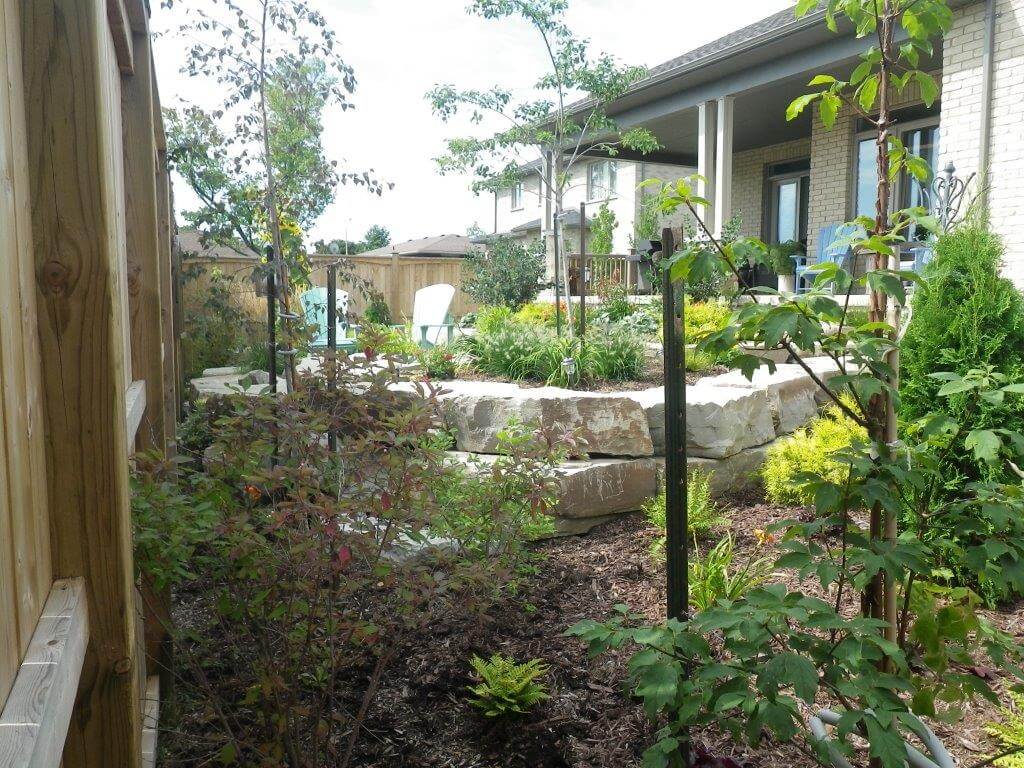
Trees
Large trees may require some maintenance in the form of trimming and/or raking leaves, but they offer many aesthetic and environmental benefits.
If you plan to add trees, give them a wide skirt of exposed earth (out to the drip line) and mulch well. This not only looks good, but furthers the reduction of grass that would otherwise need to be maintained.
Plant Selection
We’re fortunate to have myriad options when it comes to plants, flowers, and shrubs. However, if your goal is low-maintenance landscaping, you’ll want to be selective.
First and foremost, you can ensure the lowest maintenance gardens by choosing plants that are native to your region. These plants thrive in your region’s climate and soils, and historically have grown in the wild with no one but Mother Nature maintaining them. So you can bet they’ll thrive in your garden without too much attention.
Favour perennials over annuals. While the latter tend to be showier, they require more maintenance (deadheading and watering) and need to be replaced every year, adding both time and expense to your gardening requirements. To add pops of colour to your porch and patio but keep maintenance manageable, plant annuals in large containers.
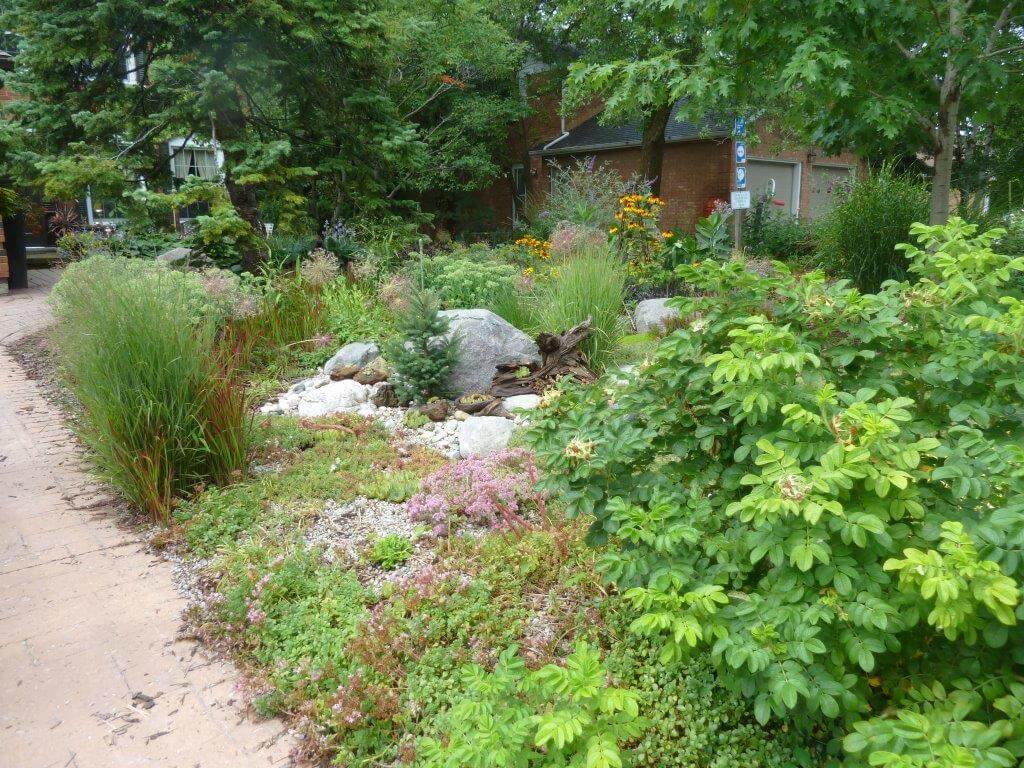
It’s important to consider sun exposure when selecting plants – both annuals and perennials – for gardens and planters. Shade-loving plants will become scorched in anything other than morning sunlight. Sun-lovers planted in the shade will not reach their full potential and will get “leggy” reaching for the sun.
While it’s visually appealing to choose a variety of shapes, sizes, and textures, be sure to select plants for your garden that have similar needs. This will help you avoid having to care for plants individually, permitting you instead to apply what maintenance is required to all plants in your garden.
Beautiful plants come from healthy soil. Soils that are rich in nutrients with good drainage and low competition from weeds will foster healthy plants without much assistance.
Good quality compost adds a wide range of nutrients and healthy bacteria to soil, and can also ensure appropriate drainage. Peat moss can also improve drainage but has an acidic pH. Raised beds also drain better than those dug down into the ground. Finally, a thick layer of mulch will help reduce watering requirements and minimize weed growth. Topped up every spring, mulch also feeds the soil and adds a polished look to flower beds and gardens.
Here in Southwestern Ontario, our outdoor living season is short, so maximize enjoyment by minimizing your work. Consider where you spend the bulk of your time and effort outside and determine ways to reduce or eliminate it so you can spend more time basking in our summer weather, while it lasts.

by A Touch of Dutch Landscaping | Jun 4, 2019 | Flowers, Landscape Design, Native Plants, Shrubs, Trees
Native plants are those that have thrived in their original region for centuries. Just like native animals, they have evolved over the years to adapt to changes in their environment.
In the last half of the twentieth century, the ever-burgeoning global marketplace opened people’s eyes to foreign and exotic varieties. Increasingly, hybrids of non-native species were created to adapt these plants to different climates.
However, in the last 15 – 20 years native species are making a comeback for several reasons.
It’s not an all-or-nothing proposition
Native varieties can generally be planted with non-native plants, assuming their sun, water, and soil requirements are similar. And the wide range of native species available means you can always find one or more that suits your gardens’ style, whether traditional, contemporary, or somewhere in between.
Enjoy your garden without having to tend to it all the time
Native plants tend are generally well adapted to their environment. So as long as you’re planting them in their preferred surroundings in terms of exposure to sun, precipitation, and soil type they should require little if any maintenance, especially once established.
Invite beneficial wildlife into your yard
One of the major reasons that native gardening is regaining popularity is its ability to attract pollinators like birds, bees, and butterflies. Native vegetation offers nutritionally-appropriate food as well as shelter to some of your region’s wildlife.
They don’t call them hardiness zones for nothing
Because your region’s original plants have evolved in your climate, they have developed certain immunities that make them more resilient in the face of pests and disease.
They’re just as beautiful and varied as their imported counterparts
While many perceive some native plants and wildflowers to be weedy and undesirable, there’s an extensive range of plants, trees, and bushes that have showy, colourful flowers and foliage, bright berries, and subtle fragrance.
If you’re interested in adding more native content to your garden, the following are some of the more popular native species, divided into five categories.
Trees
 While our country is known for the maple leaf, there are actually more than 150 varieties of maple throughout the world and only a handful of them are indigenous to Canada. But we’ve got more than just maples trees in our backyard. The range of native coniferous and deciduous trees in our region is quite diverse, each with its own unique traits.
While our country is known for the maple leaf, there are actually more than 150 varieties of maple throughout the world and only a handful of them are indigenous to Canada. But we’ve got more than just maples trees in our backyard. The range of native coniferous and deciduous trees in our region is quite diverse, each with its own unique traits.
Among our native deciduous tree species are the Ironwood, Cottonwood, and Oak, while coniferous native trees include White Cedar, Red Pine, and both Black and White Spruce.
Shrubs
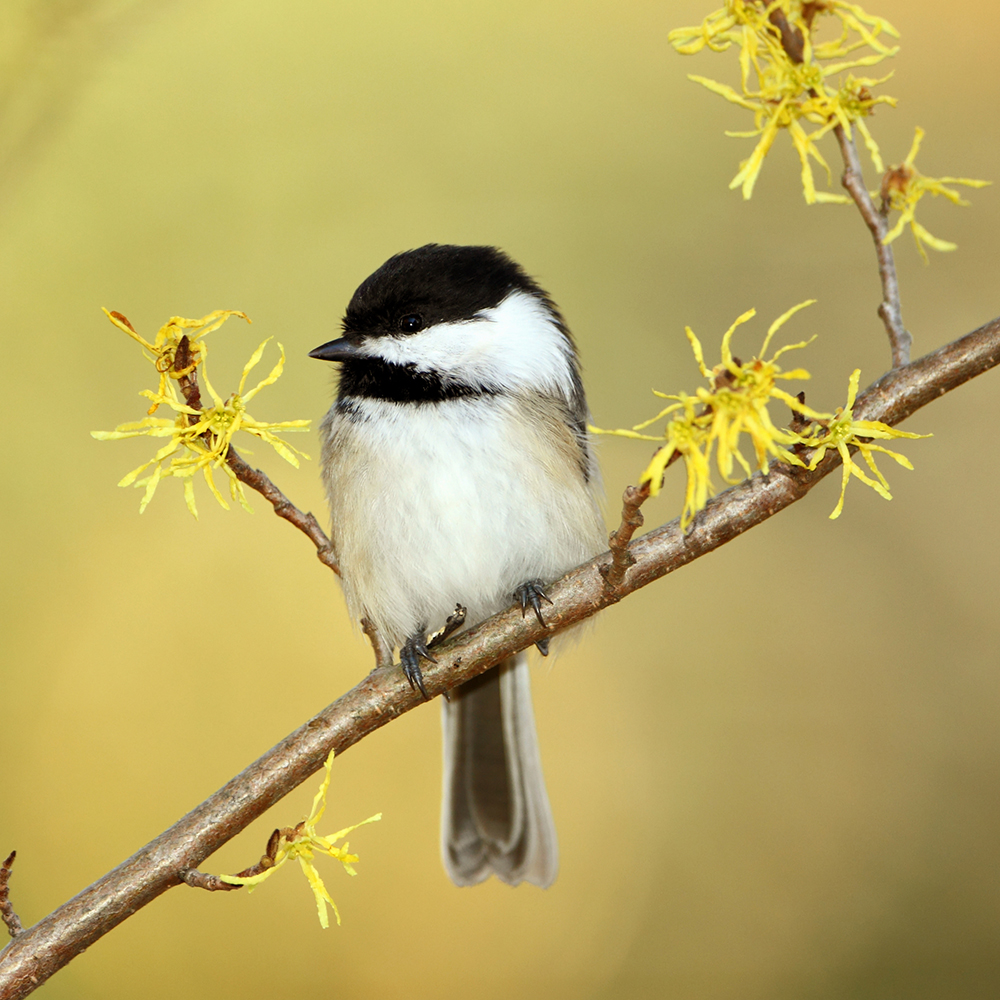 Our region offers some beautiful native shrubs that will add colour and texture to any landscape. Foliage ranges from bright green and smokey-blue, to purple and brilliant red, depending on the season. Many shrubs have a flower phase as well, temporarily enhancing its natural beauty and fragrance.
Our region offers some beautiful native shrubs that will add colour and texture to any landscape. Foliage ranges from bright green and smokey-blue, to purple and brilliant red, depending on the season. Many shrubs have a flower phase as well, temporarily enhancing its natural beauty and fragrance.
Varieties include the Honeysuckle Bush, whose flowers attract hummingbirds, bees, and butterflies. The Serviceberry is a popular native choice, covered in small white flowers in the spring and changing to brilliantly-coloured foliage in the fall. Witch Hazel shows green foliage throughout the summer and, after leaves begin to drop in the fall, shows off unique, bright yellow flowers.
Perennials
 Ontario’s hardy perennials are not only resilient but showy as well. Some are low-lying ground cover while others grow tall, which means it’s easy to create a stunning perennial garden consisting solely of native plants.
Ontario’s hardy perennials are not only resilient but showy as well. Some are low-lying ground cover while others grow tall, which means it’s easy to create a stunning perennial garden consisting solely of native plants.
Choose from brightly coloured Echinacea and Black-Eyed Susan, or pretty purple-pink Border Phlox. The fragrant Bee Balm’s flowers attract pollinators in the summer while its seed heads are a food source for birds in the winter. The Blanket Flower (in the Aster family) has sunshiney red and yellow flower heads, and Columbine can add a modern look to your garden with its long-stemmed nodding flowers.
We’d be remiss if we didn’t mention Ontario’s floral emblem, the Trillium. The beauty of this groundcover is in the simplicity of the flower. And contrary to popular belief, it is not illegal to pick a Trillium, but it’s not advisable as plants are easily damaged and difficult to successfully transplant.
Edible Fruit
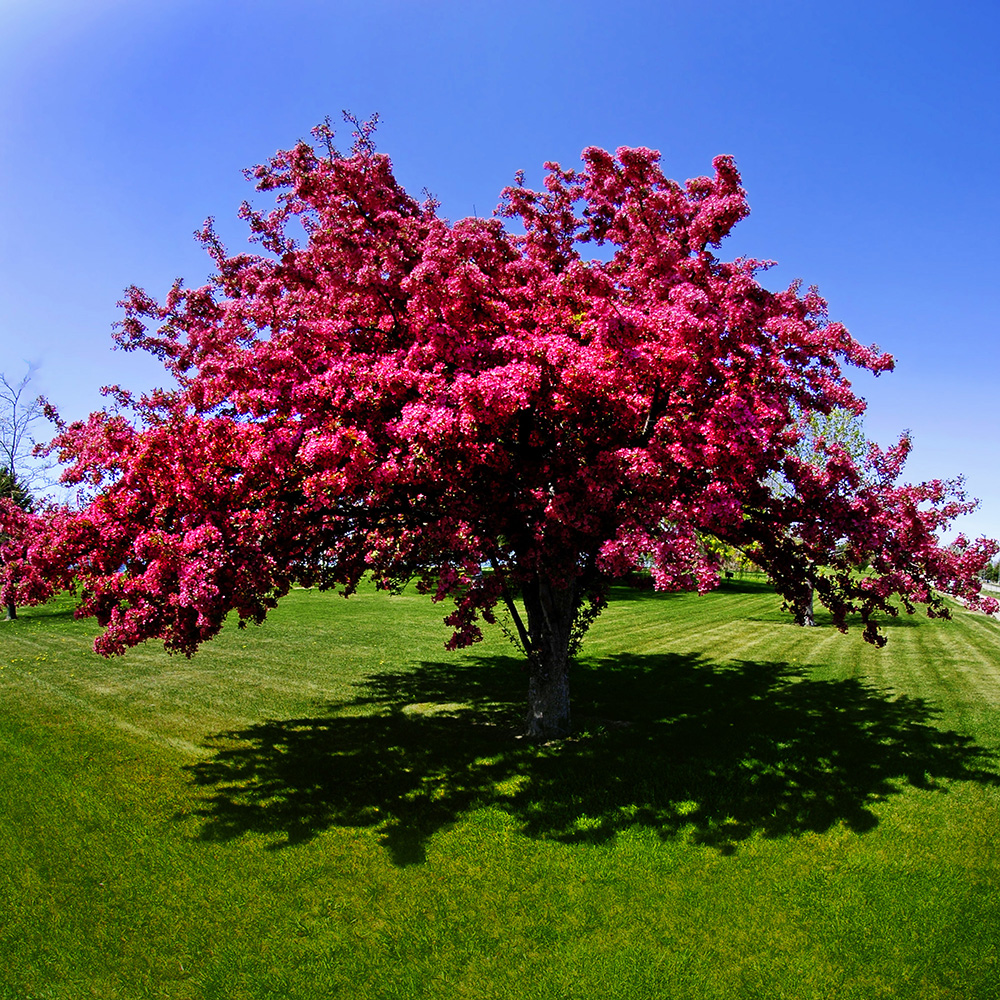 There are so many options when it comes to choosing edible fruit-bearing plants and trees native to Ontario. Various hard fruit trees like apple and crabapple varieties thrive here because they’re native to the region. Elderberry and raspberry (black, flowering purple, wild red) bushes are also native to our region and yield delicious fruit than can be eaten out of hand or baked into a multitude of desserts. The fruit of the Sumac is interesting as the berries are used as a seasoning.
There are so many options when it comes to choosing edible fruit-bearing plants and trees native to Ontario. Various hard fruit trees like apple and crabapple varieties thrive here because they’re native to the region. Elderberry and raspberry (black, flowering purple, wild red) bushes are also native to our region and yield delicious fruit than can be eaten out of hand or baked into a multitude of desserts. The fruit of the Sumac is interesting as the berries are used as a seasoning.
Ferns & Grasses
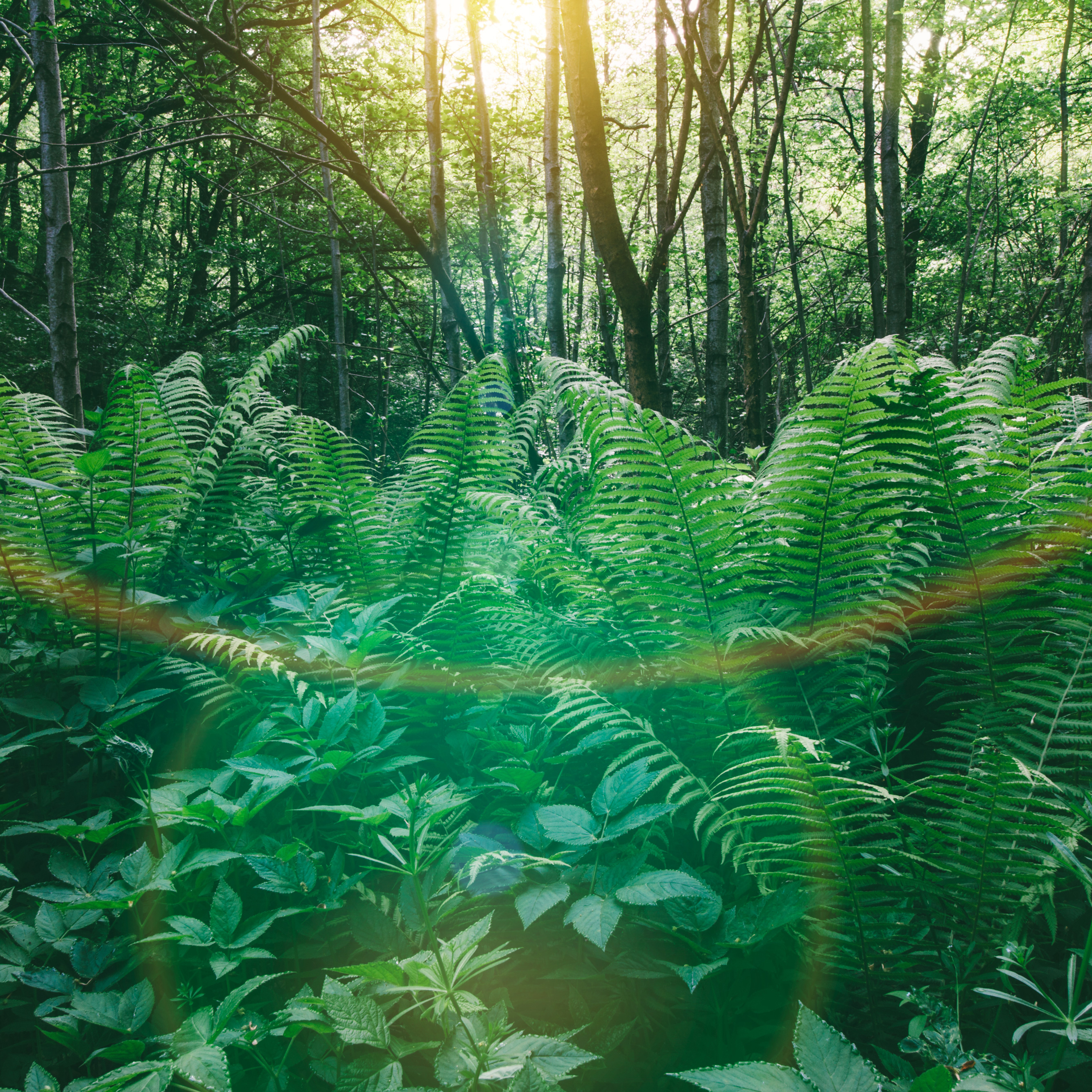 Suffice it to say that if you’re looking for native ferns and/or grasses in our region, your options are wide open. The Ostrich Fern is one of the most popular native ferns but it’s really just the tip of the iceberg. Regardless of which fern you choose, just ensure it’s planted in part to full shade with consistently moist soil. If you prefer grasses, there are myriad native varieties, both long and short. Many flower in the late summer/early fall and provide great visual interest in the winter as well.
Suffice it to say that if you’re looking for native ferns and/or grasses in our region, your options are wide open. The Ostrich Fern is one of the most popular native ferns but it’s really just the tip of the iceberg. Regardless of which fern you choose, just ensure it’s planted in part to full shade with consistently moist soil. If you prefer grasses, there are myriad native varieties, both long and short. Many flower in the late summer/early fall and provide great visual interest in the winter as well.
Gardening with native plants is not difficult. Not only are the plants, shrubs and trees easy to find at nurseries throughout the region, they’re even easier to incorporate into any landscape. If you’re interested in achieving a more beautiful native garden that attracts pollinators but you don’t want to do it yourself, contact A Touch of Dutch Landscaping & Garden Services.

by A Touch of Dutch Landscaping | Dec 5, 2018 | Foliage, Hardscaping, Native Plants, Shrubs, Trees
Most of us here in Southwestern Ontario prefer the warmer months. But when the snow falls it’s nice to still be able to enjoy your outdoor landscape, even from indoors. Visual interest in winter doesn’t have to come just from urns, wreaths, and garland that gets taken down shortly after Christmas. Hardscaping and plants provide cold-weather beauty that lasts the all season long. Below, we explore various landscaping options whose function and good looks extend well past our patio-dwelling days.
EVERGREENS
Conifers are typically top of mind when a landscaper wants to add year-round life to a garden because most keep their foliage throughout the cold months. They come in a wide range of sizes, shapes and shades of green that will compliment any home’s exterior. Some of the more popular conifers in our region are from the pine, spruce, and fir groups. And while they come from a different conifer family, cedars, cypress, and junipers, with their splayed branches, aromatic wood, and interesting bark, are also very popular.
But there’s more to evergreens than just needles and cones. Other conifer families are broad-leafed and/or fruit-bearing. These shrubs tend to have an appearance that more closely resembles a deciduous plant, but they don’t shed their leaves. Beautiful examples of broadleaf evergreens that thrive in the hardiness zones of Southwestern Ontario are Euonymous, Boxwood, and the festive favourite, Holly.
Beyond conifers, there are many trees and plants that brown or lose their leaves every year that can add structure and interest to the outdoors.
Ornamental grasses are a great example of plants that turn brow but maintain their structure through the winter and make a lovely, wispy addition to a winter landscape.
Purple Coneflower, Black-Eyed Susan, Hydrangea, and Autumn Joy Sedum shed their foliage but maintain flower stalks and/or seed heads that look beautiful under a blanket of snow.
Mountain Ash, Canadian Serviceberry, and Winterberry (a popular Holly variety) are great choices for adding pops of colour to your winter landscape. Tip: Holly berries will only form if male and female plants are established together, so be sure to purchase one of each to avoid disappointment.
Many trees offer visual interest with noteworthy texture or colour. Birch trees have a white, papery bark whose beauty is revealed after it sheds its canopy of leaves in the fall.
Stems and twigs can provide bursts of colour ranging from bright green to orange and red. In our region Dogwoods are a common shrub that add vivid colour against the white snow. And a funny-looking tree with a funnier name – Harry Lauder’s Walking Stick – adds twisty, highly textural support for freshly fallen snow.
HARDSCAPING
Don’t discount stone structures and fixed furniture as difference makers where visual interest is concerned. These hardscaping elements can add colour and texture to otherwise flat terrain.
ADDITIONAL BENEFITS
Besides enhancing the beauty of your outdoor space, landscaping and hardscaping can also play more functional roles.
Attracting birds
Trees and shrubs bearing berries or situated close to suet and seed will provide nourishment for birds including Juncos, Cardinals, Blue Jays, Nuthatches, Chickadees, Finches, Woodpeckers, Doves, and Sparrows. Dense, mature evergreens can also offer ideal shelter.
Privacy and windbreak
A properly situated row of evergreens ensures year-round privacy and can also act as a windbreak and natural snow fence, sheltering your yard from cold winds and drifting snow.
Beautiful, day and night
Outdoor lights aren’t just for the holidays. White mini lights can define the shape of a small tree or shrub. Consider lighting natural and hard elements with floodlights or projection lamps for a different but equally beautiful aesthetic at night.
Adding visual interest to outdoor spaces increases the appeal, value, and enjoyment of your home. As long as you’re selecting plants and varieties that are appropriate for your hardiness zone, your landscaping can help beautify your home not just in the warmer months, but throughout the year.






 It’s all well and good to provide seed and suet for birds, but the solution to population decline requires us to look a little closer. Instead of thinking short-term, say season by season, let’s look at it from a yearly perspective, or even longer.
It’s all well and good to provide seed and suet for birds, but the solution to population decline requires us to look a little closer. Instead of thinking short-term, say season by season, let’s look at it from a yearly perspective, or even longer. Wildlife Ecologist Doug Tallamy, author of “
Wildlife Ecologist Doug Tallamy, author of “ The good news is this isn’t an all-or-nothing proposition. You don’t have to swap out all of the plant life in your garden and risk disrupting your current modern or tropical motif, for example.
The good news is this isn’t an all-or-nothing proposition. You don’t have to swap out all of the plant life in your garden and risk disrupting your current modern or tropical motif, for example. 



 While our country is known for the maple leaf, there are actually more than 150 varieties of maple throughout the world and only a handful of them are indigenous to Canada. But we’ve got more than just maples trees in our backyard. The range of native coniferous and deciduous trees in our region is quite diverse, each with its own unique traits.
While our country is known for the maple leaf, there are actually more than 150 varieties of maple throughout the world and only a handful of them are indigenous to Canada. But we’ve got more than just maples trees in our backyard. The range of native coniferous and deciduous trees in our region is quite diverse, each with its own unique traits. Our region offers some beautiful native shrubs that will add colour and texture to any landscape. Foliage ranges from bright green and smokey-blue, to purple and brilliant red, depending on the season. Many shrubs have a flower phase as well, temporarily enhancing its natural beauty and fragrance.
Our region offers some beautiful native shrubs that will add colour and texture to any landscape. Foliage ranges from bright green and smokey-blue, to purple and brilliant red, depending on the season. Many shrubs have a flower phase as well, temporarily enhancing its natural beauty and fragrance. Ontario’s hardy perennials are not only resilient but showy as well. Some are low-lying ground cover while others grow tall, which means it’s easy to create a stunning perennial garden consisting solely of native plants.
Ontario’s hardy perennials are not only resilient but showy as well. Some are low-lying ground cover while others grow tall, which means it’s easy to create a stunning perennial garden consisting solely of native plants. There are so many options when it comes to choosing edible fruit-bearing plants and trees native to Ontario. Various hard fruit trees like apple and crabapple varieties thrive here because they’re native to the region. Elderberry and raspberry (black, flowering purple, wild red) bushes are also native to our region and yield delicious fruit than can be eaten out of hand or baked into a multitude of desserts. The fruit of the Sumac is interesting as the berries are used as a seasoning.
There are so many options when it comes to choosing edible fruit-bearing plants and trees native to Ontario. Various hard fruit trees like apple and crabapple varieties thrive here because they’re native to the region. Elderberry and raspberry (black, flowering purple, wild red) bushes are also native to our region and yield delicious fruit than can be eaten out of hand or baked into a multitude of desserts. The fruit of the Sumac is interesting as the berries are used as a seasoning. Suffice it to say that if you’re looking for native ferns and/or grasses in our region, your options are wide open. The Ostrich Fern is one of the most popular native ferns but it’s really just the tip of the iceberg. Regardless of which fern you choose, just ensure it’s planted in part to full shade with consistently moist soil. If you prefer grasses, there are myriad native varieties, both long and short. Many flower in the late summer/early fall and provide great visual interest in the winter as well.
Suffice it to say that if you’re looking for native ferns and/or grasses in our region, your options are wide open. The Ostrich Fern is one of the most popular native ferns but it’s really just the tip of the iceberg. Regardless of which fern you choose, just ensure it’s planted in part to full shade with consistently moist soil. If you prefer grasses, there are myriad native varieties, both long and short. Many flower in the late summer/early fall and provide great visual interest in the winter as well.